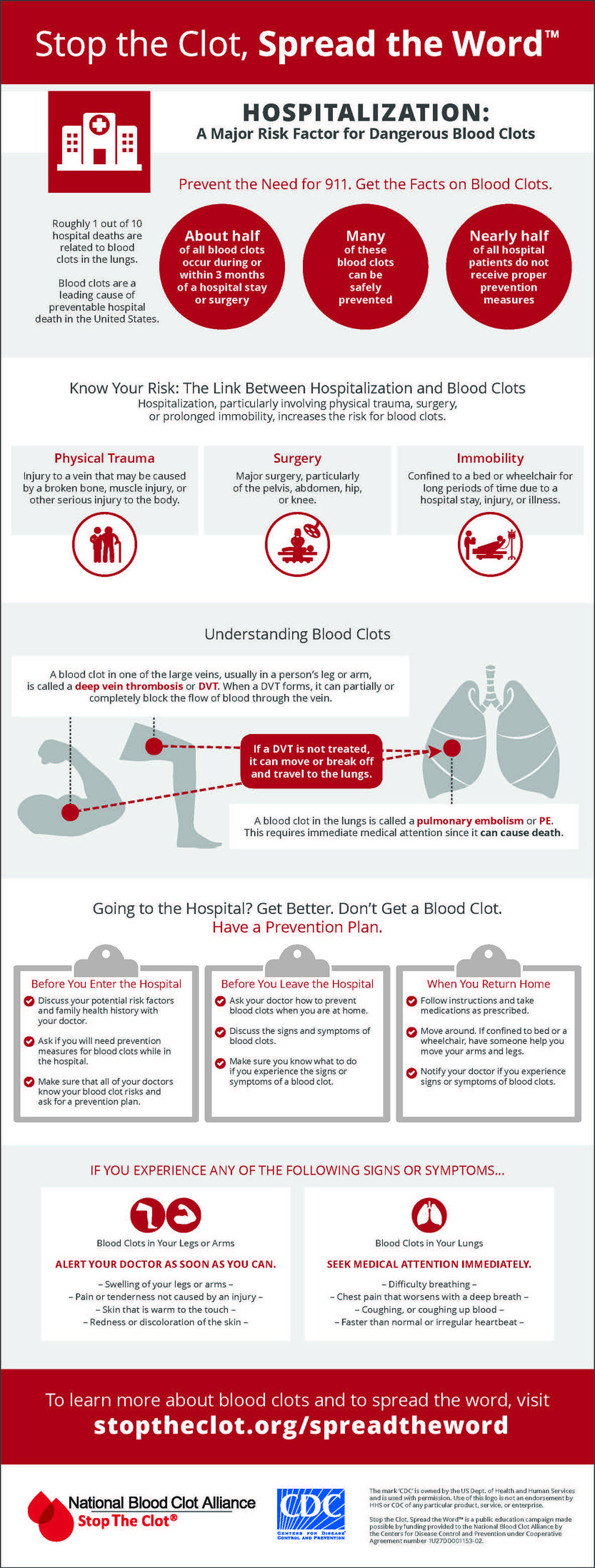Hospitalization and Blood Clots

Download:
Stop The Clot, Spread The Word [PDF – 318 KB]
Description
Title: Stop The Clot, Spread The Word
Prevent the Need for 911. Get the Facts on Blood Clots
Roughly 1 out of 10 hospital deaths are related to blood clots in the lungs.
Blood clots are a leading cause of preventable hospital dealth in the United States.
- About half of all blood clots occur during or within 3 months of a hospital stay or surgery
- Many of these blood clots can be safely prevented
- Nearly half of all hospital patients do not receive proper prevention measures
Know Your Risk: The Link Between Hospitalization and Blood Clots
Hospitalization, particularly involving physical trauma, surgery, or prolonged immobility, increases the risk for blood clots.
- Physical Trauma: Injury to a vein that may be caused by a broken bone, muscle injury, or other serious injury to the body.
- Surgery: Major surgery, particularly of the pelvis, abdomen, hip, or knee.
- Immobility: Confined to a bed or wheelchair for long periods of time due to a hospital stay, injury, or illness.
Understaning Blood Clots
A blood clot in one of the large veins, usually in a person’s leg or arm, is called a deep vein thrombosis or DVT. When a DVT forms, it can partially or completely block the flow of blood through the vein.
If a DVT is not treated, it can move or break off and travel to the lungs.
A blood clot in the lungs is called a pulmonary embolism or PE. This requires immediate medical attention since it can cause death.
Going to the Hospital? Get Better. Don’t Get a Blood Clot. Have a Prevention Plan.
Before You Enter the Hospital
- Discuss your potential risk factors and family health history with your doctor.
- Ask if you will need prevention measures for blood clots while in the hospital.
- Make sure that all of your doctors know your blood clot risks and ask for a prevention plan.
Before your Leave the Hospital
- Ask your doctor how to prevent blood clots when you are at home.
- Discuss the signs and symptoms of blood clots.
- Make sure you know what to do if you experience the signs or symptoms of a blood clot.
When You Return Home
- Follow instructions and take medications as prescribed.
- Move around, if confined to bed or a wheelchair, have someone help you move your arms and legs.
- Notify your doctor if you experience signs or symptoms of blood clots.
If you experience any of the following signs or symptoms …
Blood Clots in Your Legs or Arms
Alert Your Doctor As Soon As Yo u Can
- Swelling of your legs or arms
- Pain or tenderness not caused by an injury
- Skin that is warm to the touch
- Redness or discoloration of the skin
Blood Clots in Your Lungs
Seek Medical Attention Immediately
- Difficulty breathing
- Chest pain that worsens with a deep breath
- Coughing, or coughing up blood
- Faster than normal or irregular heartbeat
To learn more about blood clots and to spread the word, visit stoptheclot.org/spreadtheword
Top of Page- Page last reviewed: June 26, 2017
- Page last updated: July 10, 2017
- Content source:


 ShareCompartir
ShareCompartir